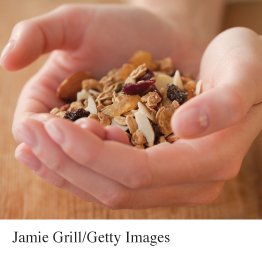Experimental design in the real world
The experimental designs we have met all have the same pattern: divide the subjects at random into as many groups as there are treatments, then apply each treatment to one of the groups. These are completely randomized designs.
Completely randomized design
In a completely randomized experimental design, all the experimental subjects are allocated at random among all the treatments.
What is more, our examples to this point have had only a single explanatory variable (for example, drug versus placebo, classroom versus Web instruction). A completely randomized design can have any number of explanatory variables. Here is an example with two.
EXAMPLE 8 Can low-fat food labels lead to obesity?

What are the effects of low-fat food labels on food consumption? Do people eat more of a snack food when the food is labeled as low fat? The answer may depend both on whether the snack food is labeled low fat and whether the label includes serving-size information. An experiment investigated this question using university staff, graduate students, and undergraduate students at a large university as subjects. Over 10 late-afternoon sessions, all subjects viewed episodes of a 60-minute, made-for-television program in a theater on campus and were asked to rate the episodes. They were also told that because it was late in the afternoon, they would be given a cold 24-ounce bottle of water and a bag of granola from a respected campus restaurant called The Spice Box. They were told to enjoy as much or as little of it as they wanted. Each participant received 640 calories (160 grams) of granola in ziplock bags that were labeled with an attractive 3.25- ×- 4-inch color label. Depending on the condition randomly assigned to the subjects, the bags were labeled either “Regular Rocky Mountain Granola” or “Low-Fat Rocky Mountain Granola.” Below this, the label indicated “Contains 1 Serving” or “Contains 2 Servings,” or it provided no serving-size information. As participants left the theater, they were asked how many serving sizes they believed their package contained. Out of sight of the participants, the researchers also weighed each granola bag. Participants’ statements about serving size and the actual weights of the granola bags are the response variables.
This experiment has two explanatory variables: fat content, with two levels, and serving size, with three levels. The six combinations of one level of each variable form six treatments. Figure 6.1 shows the layout of the treatments.

NOW IT’S YOUR TURN
Question 6.1
6.1 The perfect cup. One method for brewing coffee is the pour over. Ground coffee is placed in a filter-lined dripper (a metal or ceramic basket with holes in the bottom that fits over a carafe). Hot water is poured over the coffee and allowed to drip into the carafe. A coffee shop carries three brands of dripper, each brand differing in shape and the placement of holes through which the coffee drips. Some experts believe that moistening the filter with hot water before filling with grounds affects flavor, so the coffee shop plans the following experiment. For each brand of dripper, coffee is to be brewed both with the filter moistened and with the filter dry. A trained barista will brew two cups of coffee for each of the six combinations of dripper and wet/dry filter. A panel of trained tasters scores each cup for flavor on a scale of 1 to 10, with higher scores indicating better flavor.
What are the explanatory variables and the response variables for this experiment? Make a diagram like Figure 6.1 to describe the treatments. How many treatments are there? How many cups of coffee will be brewed?
6.1 There are two explanatory variables. They are brand of dripper and wet/dry filter. The response variable is the score for flavor on a scale from 1–10. There are three brands of drippers and wet or dry filters, so there are a total of six treatments (the six brand of dripper and wet/dry filter combinations). Two cups of coffee are brewed at each of these six treatments, so 12 cups of coffee are needed. Here is a diagram describing the treatments.
| Brand of dripper | ||||
| Brand 1 | Brand 2 | Brand 3 | ||
| Wet/dry filter | Wet | Treatment 1 | Treatment 2 | Treatment 3 |
| Dry | Treatment 4 | Treatment 5 | Treatment 6 | |
Experimenters often want to study the combined effects of several variables simultaneously. The interaction of several factors can produce effects that could not be predicted from looking at the effect of each factor alone. Perhaps longer commercials increase interest in a product, and more commercials also increase interest, but if we both make a commercial longer and show it more often, viewers get annoyed and their interest in the product drops. An experiment similar to that in Example 8 will help us find out.